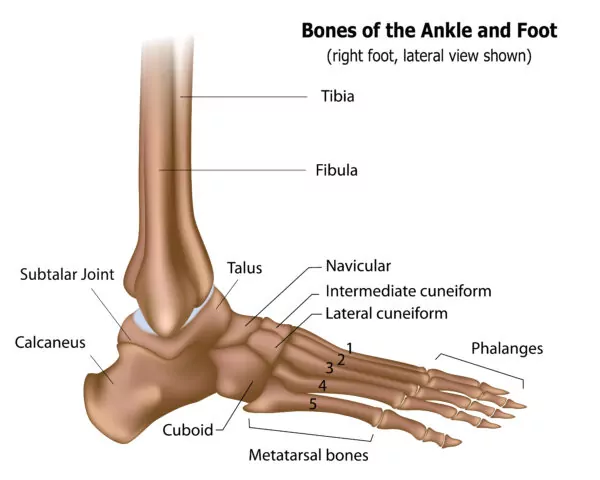Introduction Bones Of The Ankle
Bones form the skeletal structure of most animals and give shape to the body. They protect the organs in the human body while giving them mobility. There are 206 bones in the human body and are made up of hard connective tissues. Human bones can be broadly classified into 5 types – short bones, long bones, sesamoid bones, flat bones, and irregular bones. The bones of the ankle and wrist consist of long and short cubical bones. These bones make movements like walking, running, and holding things possible.
This chapter will discuss the bones of the ankle along with ligaments, nerves, and tendons.
Understanding Ankle Bones
The ankle is the point of the human body where the leg meets the foot. It helps the body to walk, run and move around easily. The bones of the ankle also provide stability to the whole body. It is a narrow part of the lower leg that joins the foot.
The word ankle has been derived from the Latin word “Angulus”. It has a very complex mechanism. The bones of the ankle make up-and-down motion possible in the human foot. The bones in the ankle also make side-to-side motion possible. Any kind of injury in the ankle bones can threaten movements like walking, running, and standing up straight.
The two major types of movement allowed by this joint are known as dorsiflexion and plantar flexion. Plantar flexion is when the top part of the foot is stretched out and moved away from the leg. On the other hand, dorsiflexion is the movement where the top of the foot can be bought close to the leg. These movements are possible because of the three essential bones of the ankle.
Bones in the Ankle
The ankle is made up of 3 bones. The 3 bones of the ankle are as follows:
Tibia
The second longest bone in the human body is the tibia. Also known as the shin bone, the tibia helps human beings to stand straight and move. This bone is located in the lower leg connecting the knee to the ankle. The whole weight of the human body falls on this bone of the ankle. It is a flat-shaped bone whose upper proximal end is joined to the knee, and the lower end contains lateral condyle, medial condyle, and intercondylar eminence. Apart from that, the shaft of the tibia, shaped like a three-sided prism, has 4 parts – anterior border, soleal line, posterior surface, and lateral border. Both the tibia and fibula are placed parallelly in the lower leg. Among them, the tibia is the stronger one.
Fibula
The second bone of the ankle joint is the fibula bone. As mentioned earlier, it runs parallel to the tibia bone joining the knee and the foot. Unlike the tibia, the fibula does not bear the weight of the body, rather, it attaches to the muscles in the legs. It is also thinner and shorter than the tibia and forms the outer part of the ankle joint. The head of the fibula bone is smaller in size and looks like a knob. The three main articulations of this bone are – the ankle joint, proximal tibiofibular joint, and distal tibiofibular joint.
Talus
Talus is a small cubical-shaped bone situated between the fibula and the tibia. This bone is located above the heel or the calcaneus bone. The formation of the lower part of the ankle is due to the talus bone. It is often referred to as the ankle bone. The calcaneus bone or the heel bone along with the talus bone makes the subtalar joint.
FAQs
Q1. What do bones of the ankle mean?
Ans. The ankle is a part of the human body that joins the lower leg to the foot. The joint of the ankle is made up of 3 bones – the tibia (also known as the shin bone that bears the weight of the human body), the fibula (the bone that runs parallel to the tibia bone and attaches the muscles in the leg), and the talus bone (the small bone that is located right above the heel bone).
Q2. Does a lump develop at the ankle of the human body?
Ans. Yes. Sometimes a lump might develop along the ankles or the wrist of the human body. Such lumps are known as ganglion cysts and are usually non-cancerous.
Q3. What kind of joint is the ankle joint?
Ans. The ankle joint is a hinge joint. The hinge joint is a type of synovial joint (movable joint). Just like the door that can either be opened or closed, the ankle joint also works only on one axis. Other examples of hinge joints are the joints of the elbows or the knees. Such joints can only be extended or flexed.
Q4. What muscles help in moving the ankle?
Ans. Muscles like the personal, calf muscles, and posterior tibialis help in the movement of the ankle. The subtalar joint also helps in movements like inversion and eversion of the ankle.
Q5. Is the tibia the strongest bone in the human body?
Ans. No, the tibia is neither the strongest nor the longest bone in the human body. The femur or the thigh bone is both the longest and the strongest bone in the human body. Tibia (also known as flute tibia) is the second largest bone in the bone and is quite strong as it bears the weight of the body. But, the tibia is definitely larger and stronger than the other leg bone, the fibula.
